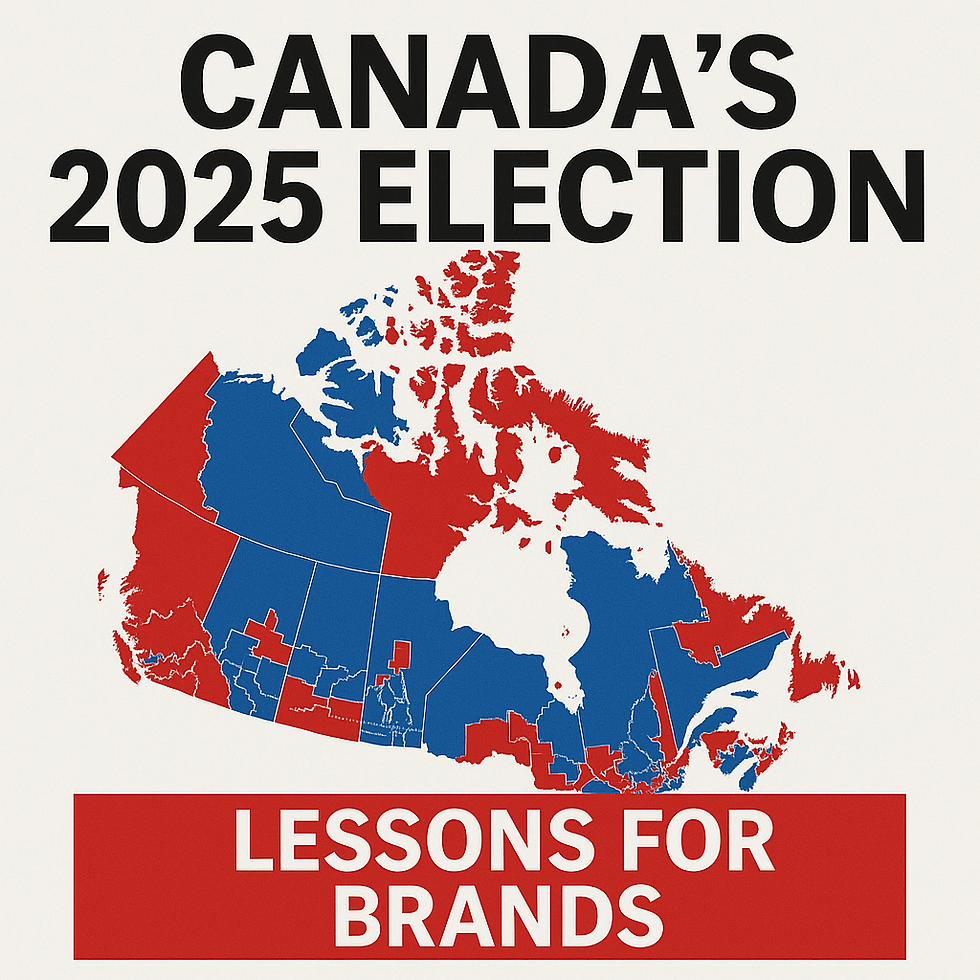Canada’s 2025 Election: A Status Quo Result Masks a Cultural Reboot
- john90345
- May 5
- 3 min read

On April 28, Canadians returned a familiar outcome: a Liberal minority government. However, what appeared to be political déjà vu was anything but. From riding-level voting volatility to deep cultural realignment, this election served as a blinking red signal for the speed at which Canada is changing.
At TerraNova360, we work at the intersection of data, culture, and commerce. What we observed in this election wasn’t merely a political shift; it was a market signal. Beneath the headlines lie insights that every brand, institution, and campaign needs to understand.
What Happened?
Despite winning the most seats, the Liberals lost ground in many traditional strongholds. The Conservatives made gains in suburban and immigrant-heavy ridings. The New Democratic Party (NDP) collapsed. The two major parties became the only real players but traded huge segments of their bases.
What’s striking isn’t the outcome; it’s the magnitude of change at the riding level. Some ridings swung more than 30 percentage points. These aren’t just "persuadables"; these are communities in motion, politically and culturally.
Beyond the Election: Additional Insights
Here’s what we’re layering into our analysis, beyond The Economist’s breakdown:
1. The 905 Shift Is a Marketing Case Study
The 905 — the suburban ring around Toronto — was once a fortress for the Liberals. But in both political and retail terms, it’s becoming Canada’s swing belt. Working-class immigrants in the 905 are:
Buying homes later in life
Feeling inflationary pressure more acutely
Consuming different media (TikTok, WhatsApp, and culturally specific channels, such as WeChat)
This echoes trends in U.S. suburbs outside Atlanta and Philadelphia — growing diversity but drifting ideologically right.
2. Erosion of Party Loyalty Mirrors Brand Loyalty Decline
Just as Canadians are switching votes between elections, they’re also switching banks, beauty brands, grocery stores, and health providers. Whether driven by values or value, we’re in an era of consumer fluidity. Loyalty must be earned and re-earned at every touchpoint.
3. Rise of Identity-First Politics — and Shopping
Data from Abacus and Environics show a growing divide between “cultural progressives” and “cultural pragmatists.” The latter often immigrant, religious, and working-class are less concerned with symbolism and more with results. This has clear analogs in marketing:
· Performative brand messages are falling flat.
· Price, quality, and community investment are gaining traction.
The Quiet Power of Media Bubbles
Another layer: information ecosystems are fracturing. Cultural communities are increasingly influenced by niche platforms, diaspora influencers, and private social media channels (Telegram, WeChat, etc.). This reshapes not just political persuasion but how trust is built.
For marketers and communicators, this means:
Mass media alone can’t carry your message.
You need trusted messengers within cultural communities.
Localization must go beyond language — it must reflect lived experience.
Looking Ahead: This Is Only Accelerating
Canada’s population is 25% immigrant and growing. By 2036, it’s projected that more than half of Canadians will be either immigrants or children of immigrants. The communities that swung this election will soon be the electoral and economic majority.
For Prime Minister Mark Carney, this means leading a nation where identity, class, and culture intersect in unpredictable ways.
For marketers? It means something just as urgent:
If your insights are based on who Canadians used to be, you're already behind.
Key Takeaways for Brands and Organizations
1. Cultural nuance matters more than ever. Don't generalize communities by ethnicity alone. Understand values, pressures, and aspirations.
2. Volatility is the new normal. Be prepared to adapt campaigns, messages, and products quickly as sentiment shifts.
3. Data must go deeper. Demographics are just the start — pair it with media habits, economic pain points, and cultural fluency.
4. Storytelling must evolve. The story of modern Canada is complex, layered, and rapidly evolving. Make sure your brand voice reflects that.
Final Word
The 2025 election didn’t just signal political change; it revealed a consumer landscape in flux. At TerraNova360, we believe this is the moment for brands to rethink how they listen, localize, and lead.
Because in Canada where even long-time voters and buyers are switching sides, the only constant is change — and the smartest organizations are those already adapting to it.



Comments